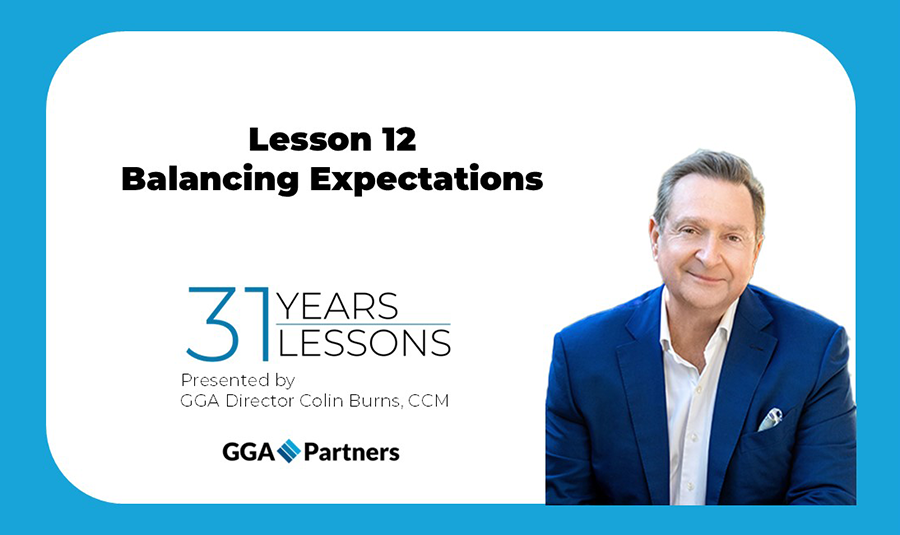
Lesson #13
of GGA Director Colin Burns’
31 years | 31 Lessons
In Lesson 13, Colin shares his experience with brand management.
It is not only what you do, but what you don’t do.

Lesson #13
of GGA Director Colin Burns’
31 years | 31 Lessons
In Lesson 13, Colin shares his experience with brand management.
It is not only what you do, but what you don’t do.
No stranger to innovation, Bob Dylan recorded “Like a Rolling Stone” in early summer of 1965 causing Bruce Springsteen to say of the first time he heard it, “[it] sounded like somebody’d kicked open the door to your mind.” The song was innovative and wildly admired in numerous ways and changed popular music for years to come. Innovation seldom comes in such a lightning bolt.
In the wake of a once-in-a-century event like the coronavirus pandemic, what innovations has your club introduced? Some of the most interesting innovations tie to the growing capabilities of artificial intelligence (AI) where performance diagnostics for golf and tennis; where applications of technology are enabling more seamless facial recognition which enable club personnel to eliminate the confounding “what is your number” question; and where advanced cybersecurity can protect private club members’ identities and confidential information. The possibilities are like a rolling stone.Three innovations worthy of consideration for your club:
1. Performance Enhancement Capabilities – One golf swing analysis chamber is not enough, as most clubs have found. Then, two are found to be lacking in most clubs and only when clubs commit to making athletic performance facilities a central feature in their approach to innovation do they prosper.
The reasons most often found in clubs taking this big step are three-fold:
Enthusiastic users are seen by other members as “hogging” the new amenity and, thus reducing others’ enjoyment or experimentation.
The social enjoyment, where groups of golf or tennis enthusiasts gather for informal “leagues” during off-season and inclement weather conditions. The blend of athletic, competitive, social seems to be popular with club members.
The pressure on club boards to find new and interesting activities escalates with each advancement.
Golf training and swing analysis capabilities are exceedingly popular. Bear in mind that a tennis stroke can be analyzed if a golf swing can be. And then, there will be pickleball.
2. Personnel Development Methods –Many club leaders are answering questions about the quality of member services and innovative managers are turning to new-found programs and resources for teaching service capabilities to a higher and more consistent levels.
“To effectively shape training and development initiatives, it’s crucial to incorporate the employee experience,” says Eric Hutchison, PhD, Director at GGA Partners. “Leveraging new technologies alongside established knowledge has unlocked a vast array of training possibilities for enhancing upscale member services.”
How does it feel to be on your own when capabilities are building all around?
3. Emotion-Based Member Activities – Members join clubs for many reasons. Eric Brey, PhD, another Director at GGA Partners, reports, “Club members indicate they are most satisfied with the emotional value they receive from their membership. This value is created from the feelings they have toward their membership.”
Socialization – The desire to interact with friends and family dominates this point of emphasis. Part of the human condition, socialization is one of the basic needs clubs serve.
One of the most impactful innovations in clubs has been the growth of open-air or al fresco dining experiences that emerged responding to Covid-period social distancing guidelines. From this concept, some clubs are capitalizing on open-air member events like a Sunday afternoon picnic which underscores all members desire for a safe setting for activities which bring friends and families together.
Personalized Service – Many members want to be recognized and treated as “special” as part of feeling comfortable at their club. Clubs that provide personal recognition – like being called by name without prompting – fulfill this need of many members.
Wine programs where members’ names are attached to their own bin filled with wines chosen for them. Next-generation ideas emerging bring forward bespoke menus for small member gatherings…think of a catered event on a smaller scale of 10 to 20 members per event.
Who wants to be a complete unknown with no direction home?
Innovation in private clubs is emerging as a platform for market differentiation and competitive advantage. Club leaders who recognize these opportunities provide valuable opportunities for their clubs’ service to members’ needs.
GGA Partner Henry DeLozier penned this article.

Lesson #12
of GGA Director Colin Burns’
31 years | 31 Lessons
We’re all been taught to exceed member expectations, but sometimes that simply isn’t possible.
Colin shares the importance of communications to balance expectations.
Peter Drucker famously advised, “Culture eats strategy for breakfast.”
And he was correct. In a private club “culture” is governance. Club leaders do well to place themselves and their clubs at the intersection of governance and strategy. Five keys for clubs that master blending governance and strategy are shown below:
1. Be intentional. Making your club’s governance better – more trusted…more transparent…more business-like – is one of the primary goals.
Sound and trustworthy governance follows business planning that is organized, deliberate, and time oriented. In day-today parlance it is a matter of telling people what you will do and doing it to the best of your ability. Sound strategic planning for a private club involves: (a) informing members as to what the club’s leaders will do, (b) providing timely updates to inform all members, (c) adjusting to changing or emerging circumstances, and (d) executing a thorough plan that has been shared with all members.
By definition, strategic planning is a process-driven method for identifying key goals and objectives and the methods that will be used to answer the question: what?
2. Build the business case for sound governance. Show how strategy delivers and keeps your club’s members engaged, happy, and supportive. Most club members want to know several simple things: (a) what the Club stands for – as described in its mission, vision, and core values; (b) the primary goals that their board will pursue to deliver on the club’s promises; and (c) accountability by the board to the general membership for the decisions that are made with their resources if time and treasure.
“We need to decide who we want to be when we grow up.” This over-simplified statement is often the one used by club members when describing club’s which lack clearly stated and understood purpose. Club leaders do well when they can clearly state the club’s purpose.
The business case for sound governance involves reliable financial performance on which most members place great importance and the assurance that “the club will continue to be what I want it to be.” Since clubs evolve in real time, club leaders must regularly update and revise the club’s purposes to ensure that the club remains relevant to most members.
3. Set a process map and timetable. Trustworthy, transparent governance requires stating one’s intentions and reporting regularly in a time-oriented manner. Stated simply, “plan your work and work your plan.”
Process maps are everyday corporate tools which provide structure, organization, time references, and accountability. The most useful process maps used in private club settings – such as a GANTT chart – show (a) what is to be done and (b) when it is to be completed. Nothing complicated here.
Timely updates which are redundant messaging using multiple media – such as email, hard copies, and social media links – help interested members to understand how the club is being effectively governed and lead.
4. State the strategic goals clearly and simply. Best practice goal setting relies upon four to six annual strategic goals. Select the goals that will most effectively move the club forward constructively and address the club’s primary needs.
Review the difference between strategy and tactics to ensure that your club’s goals are not tactical. The operating or business plan are the place for the tactical objectives. A key to dependable governance is the board members’ ability to remain focused on the big-picture strategic goals.
5. Measure and report the board’s performance on a strategic scorecard. Demonstrating to ordinary members of the club that they board understands that it is accountable to members is a cornerstone for sound governance.
Keep score on the four to six strategic goals and update the scorecard quarterly. In addition to simple email blasts, conduct quarterly meetings with members to update them regarding strategy…and don’t be dragged into the tactical weeds with concerns of the day.
The intersection of governance and strategy defines the future success of your club.
GGA Partner Henry DeLozier penned this article for Boardroom Briefs. It appeared in the August 3, 2024 edition.
Launched in 2020 to benchmark operational data and examine trends while exploring timely topics to address new challenges and take advantage of market opportunities, this year’s annual survey shows:
About GGA Partners
GGA Partners™ is an international consulting firm and leading advisor to many of the world’s most successful golf courses, private clubs, resorts, and residential communities. We work with owners, asset managers, club and community leaders, investors and real estate developers tackle challenges, achieve objectives, and maximize asset performance. Established in 1992 as the KPMG Golf Industry Practice, our global team of experienced professionals leverage in-depth business intelligence and proprietary global data to deliver impactful strategic solutions and lasting success. GGA Partners has offices in Toronto, Ontario, West Palm Beach, Florida, Phoenix, Arizona and Dublin, Ireland.
GGA Partners is proud to be a long-standing CMAA Business Partner.
For further information, contact:
Dr. Eric Brey, Ph.D.
Director
GGA Partners
t: 715.505.7716
e: eric.brey@ggapartners.com
For additional information the Club Management Association of America, visit: cmaa.org